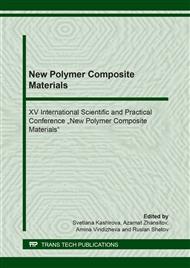p.244
p.250
p.255
p.260
p.266
p.271
p.279
p.285
p.290
Reversible Wettability Effect of the Organic-(≡TiO)n- Inorganic Terpolymers Surface
Abstract:
The optically transparent organic-inorganic terpolymers were obtained on the basis of poly (titanium oxide) and organic monomers of the vinyl series, characterized by the reversible wettability of the surface. The poly (titanium oxide) inside the material had a structure close to anatase and was uniformly distributed over the surface of the sample as it was determined by X-ray phase analysis and electron microscopy. A single-electron transition Ti4++ e ̅ → Ti3+ occurred in the samples under UV-irradiation accompanied by a breaking of the Ti-O bond and a decreasing of the terpolymers transparency from 90% to 20%; the process was reversible in time. The reversible of the samples surfaces from hydrophobic to hydrophilic were observed. The water wetting angle varied within 80 °↔ 5 ° range.
Info:
Periodical:
Pages:
266-270
Citation:
Online since:
August 2019
Authors:
Price:
Сopyright:
© 2019 Trans Tech Publications Ltd. All Rights Reserved
Share:
Citation:


